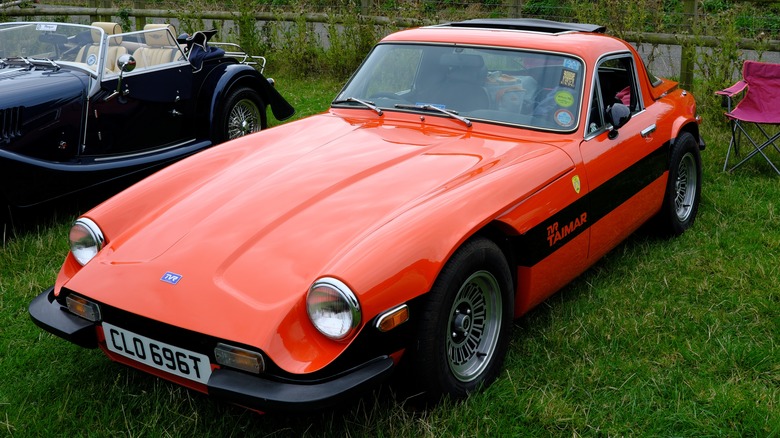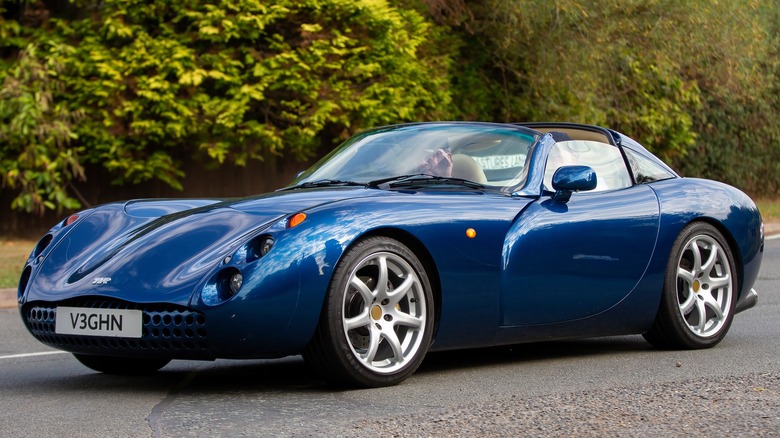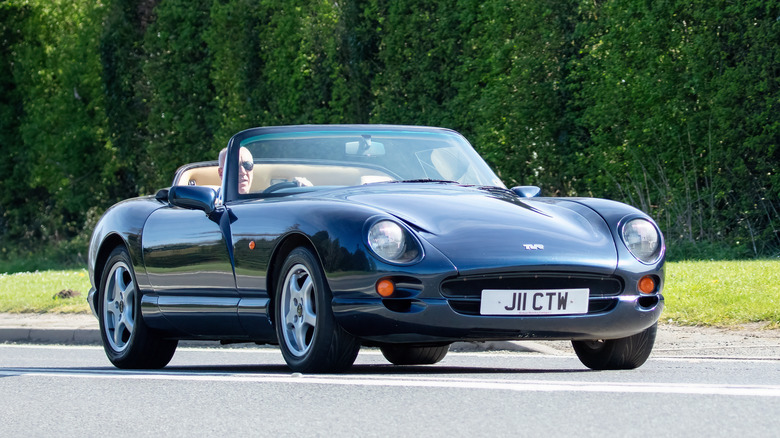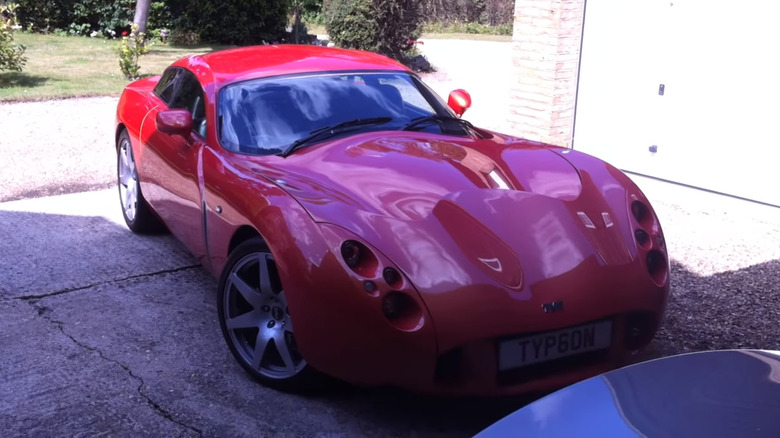9 Of The Best TVRs Ever Made, Ranked
Few marques fit the stereotype of "small British car manufacturer" better than TVR. Since Trevor Wilkinson first set up his small shop in 1947, TVR has been through numerous scandals, bankruptcies, and changes of ownership, but a few things have always remained consistent. TVRs have always been a blast to drive, following the simple but effective formula of putting a powerful engine in a small, lightweight car. The cars have also always been comparatively rare. Even the brand's most successful models have been produced in much lower numbers than American or German rivals.
TVR has developed a reputation for questionable reliability over the years, although some models have proven themselves to be more dependable than you might expect. The stereotype of unreliability is one that the brand's current owners are keen to shake off with its latest car, the reborn Griffith, which TVR insists is on the way soon. Pandemic-related delays and issues with investors have meant years of setbacks for the struggling company, with the car originally slated to enter production in 2018. The latest reports claim the first units should be delivered to customers in 2024, barring any further delays. If that's true, then the first new TVRs in over 15 years might be only a few months away — so, it's a great time to take a look through the brand's back catalog and celebrate some of TVR's best cars.
TVR Taimar Turbo
Turbocharging has become increasingly common across all segments of the car industry as manufacturers attempt to reduce emissions without compromising on power, but in the early '70s, the technology was still in its infancy. A number of British manufacturers were then experimenting with turbos, with one of the earliest being TVR. The first TVR to receive the turbo treatment was the Taimar, an M-Series model that was based on the 3000M. The biggest difference between the two was that the Taimar featured a rear glass hatch to make it easier to load luggage in and out of the car, rather than having to wedge it over the seats as with the 3000M.
The more practical model proved to be a hit, with 395 examples sold, and so TVR contracted tuning specialist Broadspeed to develop a more powerful Turbo version. In total, 33 Taimar Turbos were built, including three Turbo SE models with additional equipment. The Turbo reportedly produced 230 horsepower and boasted a top speed of 145 mph, considerably faster than the 121 mph top speed of the naturally aspirated Taimar.
TVR Tuscan
TVR boss Peter Wheeler was famously never a fan of safety regulations, opting to eschew things like ABS or airbags around the turn of the century in order to save money and weight. However, that meant cars like the Tuscan ended up getting banned in America, cutting TVR off from a key market that had previously been one of its most successful export territories. It's also a shame as the Tuscan was a more sensible car (at least by TVR standards), with its six-cylinder engine delivering enough power to shred its tires at full throttle, but with smooth delivery meaning that driving it on the highway was easier than ever.
It's wild looks and inconsistent build quality remained unchanged, but for TVR buyers, that was all part of the fun. Its starting price of £39,750 (around $91,000 adjusted for inflation) made it significantly cheaper than rivals from Porsche or Ferrari, even if it was capable of delivering performance similar to both of them. The good news for American enthusiasts is that the first Tuscan models were delivered to customers in 2000, which means it's not too much longer until they'll be able to import under the 25-year rule.
TVR Chimaera
The Chimaera had a long production run for a TVR, spanning from 1992 up to 2003. In that time, it became the best-selling TVR model ever, with the TVR Car Club reporting that there were more Chimaeras produced than the previous 25 years of TVR's output combined. The reason for its success was that it struck the balance between a brutish muscle car and a civilized grand tourer, making it more approachable than most of the brand's previous offerings. It shared much of its underpinnings with the Griffith but boasted revised suspension for a smoother ride and more luggage space than its stablemate.
According to TVR folklore, three designers worked on the car: Peter Wheeler, John Ravenscroft, and Ravenscroft's dog, Ned. It was Ned that was apparently responsible for the Chimaera's distinctive front indicator light recesses, after he damaged part of an early clay mock-up. While the styling remained largely unchanged throughout the car's decade-plus on sale, the range of engines increased later in its lifespan. Early 4.0L cars reportedly made 240 horsepower, while the most powerful later-model cars upped that figure to 340 horsepower. They're a rare sight in the U.S., but can be surprisingly affordable: Data from Classic shows an average sale price of just $19,702, with the lowest recorded sale fetching just $8,010. However, rust and poor maintenance mean that buying a cheap example is a risky business, and could end up costing more in the long run.
TVR Grantura
The Grantura was not only the first TVR production model but it gained the fledgling sports car maker its first real publicity on the international stage. Trevor Wilkinson's company had been selling cars in kit form for a few years prior, including some in the U.S. Ray Saidel, one of the brand's American importers, pitched the idea of redesigning the TVR kit into a more conventional road-going sports car. At the time, the company was undergoing the first of what would turn out to be many financial rough patches, and Wilkinson eventually left the company and handed control to Keith Aitchison and Bryan Hopton.
The two men continued to develop the Grantura and expand their clientele. While only around 100 examples of the MkI Grantura were built, the MkII, unveiled in 1961, saw around 400 orders. The car continued to be developed until 1967, albeit with a brief pause in production when the company went bankrupt again in 1965. It was rescued by Martin and Arthur Lilley, two TVR owners and company investors who went on to helm TVR for the next 15 years.
TVR Griffith
Unveiled to the world at the 1990 Birmingham Motor Show, the TVR Griffith was the start of a new era for the company. Its previous cars for the past decade had been wedge-shaped, but there was little more that designers could do to improve their performance, and so it was decided that a radical new shape would have to be developed. The resulting streamlined body of the Griffith is considered one of TVR's best designs, and proved to be a smash hit, with one order reportedly being taken every eight minutes of the Motor Show. The Griffith is mechanically very similar to the Chimaera, but it was designed as the more hardcore of the two cars and was produced in smaller numbers.
It was also significantly more reliable than TVRs of years past, with well-maintained models generally continuing to be dependable today, at least by classic sports car standards. The Griffith ended up being so popular that TVR had to pause orders in 1992 to catch up with the backlog and give the factory some time to prepare for the launch of the Chimaera, and production of the car continued until 2001. The Griffith name has been resurrected for the new, upcoming TVR car, although ironically, the '90s car was itself a revival of the nameplate that was first used on TVRs in the '60s.
TVR Typhon
Depending on whom you ask, there are either four TVR Typhons in existence, three of them, or just one. The model evolved from the Tuscan R, which was a road-going version of the Tuscan Le Mans race car. From there, the car was developed further and renamed the T400, and order books were opened to customers. A later T440 model added two small rear seats, and finally, the factory-designated Typhon added a supercharger and a six-speed sequential gearbox. Confusingly, the T440 and T400 models have also been rebadged as Typhons by their respective owners, even though they're less powerful and weren't originally given that designation by the factory.
What's certain is that the one official factory-badged Typhon was brutally fast, with a reported 550 horsepower on tap. Thanks to its entirely carbon-fiber body shell and stripped-out interior, it weighed less than 2,400 pounds with an estimated top speed well north of 200 mph. However, it's thought that problems with heat build-up during development were the reason that so few examples of the car were ever built, with TVR's precarious financial position meaning the project eventually got shelved even though customer deposits had already been taken.
TVR Griffith 200/400
The original Griffith of the '60s was essentially a Grantura modified slightly to accommodate a Ford 289 V8 engine, in the same style that Carroll Shelby had done a few years earlier with the AC Cobra. In fact, the Griffith was reportedly so fast that it could actually beat a Cobra in a straight line, although questionable build quality and handling meant that achieving high speed in the car would have been a potentially terrifying experience. That build quality was in part a result of TVR's need to quickly ramp up production while having access to limited funds, leading to inconsistencies between cars.
The cars were then shipped to America without engines and had their Ford V8s fitted by Jack Griffith, the auto dealer from which the car took its name. The combination of a small car and a large engine meant the original Griffith had some niggling issues which never got resolved: one of them was heat build-up in the cabin, which made the car unpleasant to drive for any length of time. Another was the overly sensitive steering, which would twitch and send the car in a random direction at the slightest hint of a bump in the road. Despite their inherent flaws, the early Griffiths developed a reputation as some of the fastest cars on the road, and today, they're a highly sought-after collector's item.
TVR Cerbera Speed 12
Given TVR's propensity for unleashing unruly, uncompromising performance cars, it's difficult to imagine what it would take for a car to be deemed too powerful to release. The Cerbera Speed 12, however, earned that unlikely title, as it was axed after company boss Peter Wheeler took it for a drive. The story goes, he took it home after work and returned the following morning convinced that it should never be released to the public, as it was simply too difficult to control. It was originally developed from TVR's Cerbera race car and used a 7.7L V12 engine, which was essentially two of the brand's six-cylinder engines fused together.
It was so powerful that it broke the company's dyno the first time anyone tried to measure it, but eventually, a rough estimate of 800 horsepower was given. Orders for the car were opened and development continued, but after Wheeler's unexpected decision, only one example ended up being produced. It was sold to a buyer personally chosen by the company boss and recently came up for sale once again at Silverstone Auctions in England. It sold for £601,500 (roughly $760,000), becoming the most expensive TVR ever in the process. With such excitement surrounding the car at the time of its development, the decision to scrap it was a head-scratcher at best, but at least one example of this brutal machine was eventually produced.
TVR Sagaris
While TVR's tendency to produce cars that were difficult to drive made it endearing to long-time fans, by the early '00s it had become increasingly evident that the company couldn't survive on the custom of those fans alone. An attempt had to be made to broaden TVR's appeal without losing its edge, and the resulting Sagaris did a surprisingly good job of that. It still looked the part — that is, it looked outlandish and completely unlike anything else on the road — but it was tamer to drive, and wouldn't necessarily punish every driver mistake by careering headlong into the nearest wall.
It still suffered from inconsistent build quality, but to a lesser degree than certain other TVR models. It was still cheaper than its rivals, even if it was hardly what you'd call a bargain. It also featured the usual number of TVR-specific design quirks, including door releases mounted under the wing mirrors. But crucially, it wasn't quite such a handful on the road. Russian investor Nicolai Smolenski had bought the company in 2004, shortly before the Sagaris was unveiled, but unfortunately, neither new ownership nor the new car could bring about a change in the brand's financial fortunes, and TVR declared bankruptcy in 2006. To date, the Sagaris remains the brand's last production car.









